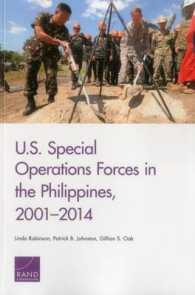- ホーム
- > 洋書
- > 英文書
- > Computer / General
Full Description
"Lean Integration is an excellent resource for anyone struggling with the challenges of performing integration for a complex enterprise." -Steve J. Dennis, Integration Competency Center Director, NikeUse Lean Techniques to Integrate Enterprise Systems Faster, with Far Less Cost and RiskBy some estimates, 40 percent of IT budgets are devoted to integration. However, most organizations still attack integration on a project-by-project basis, causing unnecessary expense, waste, risk, and delay. They struggle with integration "hairballs": complex point-to-point information exchanges that are expensive to maintain, difficult to change, and unpredictable in operation.The solution is Lean Integration. This book demonstrates how to use proven "lean" techniques to take control over the entire integration process. John Schmidt and David Lyle show how to establish "integration factories" that leverage the powerful benefits of repeatability and continuous improvement across every integration project you undertake.Drawing on their immense experience, Schmidt and Lyle bring together best practices; solid management principles; and specific, measurable actions for streamlining integration development and maintenance.Whether you're an IT manager, project leader, architect, analyst, or developer, this book will help you systematically improve the way you integrate-adding value that is both substantial and sustainable.Coverage includesTreating integration as a business strategy and implementing management disciplines that systematically address its people, process, policy, and technology dimensions Providing maximum business flexibility and supporting rapid change without compromising stability, quality, control, or efficiency Applying improvements incrementally without "Boiling the Ocean" Automating processes so you can deliver IT solutions faster-while avoiding the pitfalls of automation Building in both data and integration quality up front, rather than inspecting quality in later More than a dozen in-depth case studies that show how real organizations are applying Lean Integration practices and the lessons they've learned Visit integrationfactory.com for additional resources, including more case studies, best practices, templates, software demos, and reference links, plus a direct connection to lean integration practitioners worldwide.
Contents
List of Figures and Tables xvForeword xixPreface xxiiiAcknowledgments xxviiAbout the Authors xxixIntroduction xxxiPart I: Executive Summary 1Chapter 1: What Is Lean Integration and Why Is It Important? 3Constant Rapid Change and Organizational Agility 5The Case for Lean Integration 9What Is Integration? 11Integration Maturity Levels 14Economies of Scale (the Integration Market) 16Getting Started: Incremental Implementation without "Boiling the Ocean" 20Chapter 2: A Brief History of Lean 23The Lean System 29The Lean Practices 34Lean Application Trends 41Case Study: The Value of Lean in Service Industries 44Chapter 3: The Integration Factory 45What Is an Integration Factory? 46The Integration Factory as an Element of an ICC 52How Does the Integration Factory Work? 55Integration Factories as Self-Service ICCs 64Part II: Applying Lean Principles 67Chapter 4: Focus on the Customer and Eliminate Waste 69Focus on the Customer 70Integration Wastes 74Case Study: Waste Elimination at Clicks-and-Bricks 81Case Study: Waste Elimination at Big Bank 85Focus on the Integration Value Chain 87Chapter 5: Continuously Improve 89Continuous Learning and Knowledge Management 90Case Study: Continuous Improvement at Clicks-and-Bricks 91Chapter 6: Empower the Team 103What Is a Team? 104Examples of Empowered Teams in Software 107Creating an Empowered Lean Integration Team 109Leadership and Vision 112Important Practices That Help Enable Empowered Teams 117Organizing the Team: Thoughts on Organizational Structures 120Case Study: Smith & Nephew-Integrating Lean Principles with Data Quality 122Chapter 7: Optimize the Whole 131Optimize the Whole Rather than Optimize the Parts 132What Is "the Whole"? An Introduction to Value Stream Mapping 134Selecting Metrics to Optimize the Whole 139Chapter 8: Plan for Change and Mass-Customize 145Techniques for Enabling Constant Change 146Mass Customization 152Case Study: Using Mass Customization 159Chapter 9: Automate Processes and Deliver Fast 163Pitfalls of Automation-Building "Stuff" Faster 164Delivering Fast 167Automating Processes-Using the Computer to Make Complexity Manageable 169Case Study: Automating Processes at Wells Fargo Home Mortgage 174Chapter 10: Build Quality In 181Two Areas of Quality: Data Quality and Integration Quality 182Quality Evolution and Lean 184Data Quality 185Integration Quality 192Case Study: Building Quality In at a Utility Company ICC 198Part III: Implementation Practices 203Chapter 11: Financial Management 205Challenges 207Activities 214Business Case Development 215Case Study: A "Creating the Wave" Investment Strategy 236Case Study: Enterprise Data Warehouse Rationalization Business Case 238Chargeback Accounting 240Chargeback Case Studies 250Chapter 12: Integration Methodology 253Activities 256Agile versus Lean Methodology 263Case Study in Simplicity: The Architecture of the Web and REST versus SOA 269Engagement Services Management 271Case Study: Integration Methodology in a Decentralized Enterprise 274Chapter 13: Metadata Management 281Metadata Scope for Lean Integration 284Metadata Management Framework 285Challenges 289Prerequisites 292Industry Practices 293Activities 295Chapter 14: Information Architecture 301Challenges 304Prerequisites 308Activities 309Methodology 310Information Architecture Models 312Data at Rest 317Chapter 15: Business Process Management 321Data-in-Motion Models 324Activities 326Architecture 328Case Study: The Post Closing Systems Architecture 330Chapter 16: Modeling Management 333Service-Oriented Architecture Can Create a New Hairball 336Challenges 339Coupling and Cohesion Framework 343Canonical Modeling Techniques 345Navigating the Modeling Layers 350Activities 352Case Study: European Interoperability Framework 357Case Study: Object-Relational Mismatch 359Chapter 17: Integration Systems 361What Is an Integration System? 362Integration Systems Taxonomy 364Challenges 369Industry Practices 370Activities 371Portfolio Rationalization 378Appendix A: Lean Terminology 387Appendix B: Integration Laws 395Law #1: The Whole Is Greater than the Sum of Its Parts 395Law #2: There Is No End State 396Law #3: There Are No Universal Standards 396Law #4: Information Adapts to Meet Local Needs 397Law #5: All Details Are Relevant 397Appendix C: Glossary 399Common Acronyms 399Definitions 400Index 409








